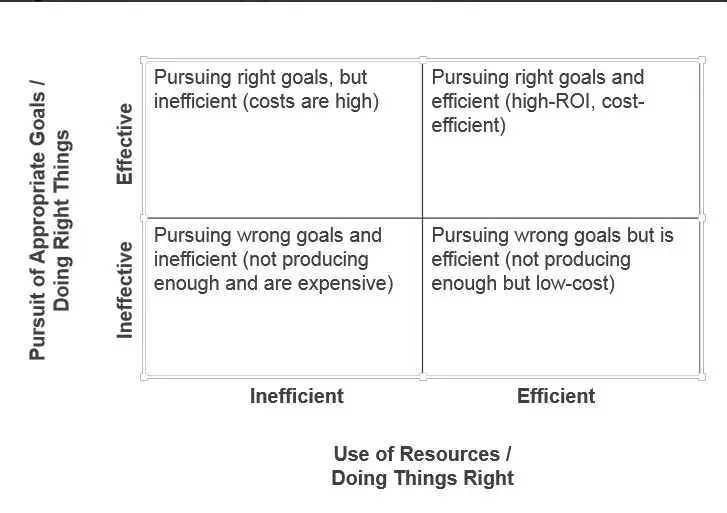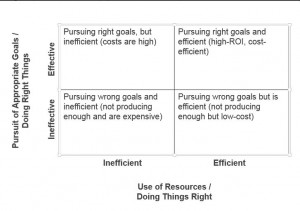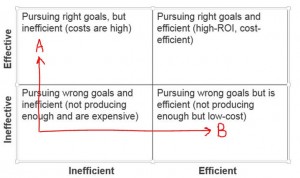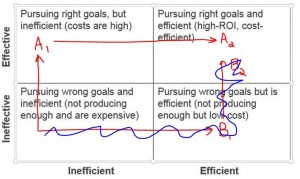For the past year I have been trying to wrap my brain around the paradoxical relationship between effectiveness and efficiency in small businesses. I have understood that one can be effective without being efficient but I could not reason why. I kept thinking this was a reality that persisted in spite of itself and ultimately was not an appropriate one to accept. I was wrong.
If you have been a part of a small business for any amount of time you know that disorder and inefficiencies are constant. Rework and second tries eat up potential profits all day long and yet the mode of operation continues. How can this be? Why can’t organizations get their act together and address the core issue leading to this waste? The answer may surprise you.
While digging for answers I came across the following matrix which expresses the relationship nicely;
I don’t know if http://www.insightsquared.com/2013/08/effectiveness-vs-efficiency-whats-the-difference/ was the original author of the image but that is where I found it. In the article they go on to explain the effectiveness is doing the right thing and efficiency is doing things right. This is rather straight forward and sounds very similar to the maxim: “Leaders figure out the right things to do while managers figure out how to do things right.” I stewed on this for a bit to see if there was anything I could garnish to aid in reconciling the dichotomy. At first I saw nothing but it soon dawned on me that the conflict was less a conflict and more a rite of passage.
Let us pretend that we are stating an organization and we begin at the corner of ineffective and inefficient. We have two paths to choose from; Path “A” leads us to the world of the inefficient and effective. Path “B” leads us to the land of efficient and ineffective.
As far as this matrix is concerned companies must begin in the lower left and work towards the upper right. The question is how. To stay viable smaller organizations would be wise to first do the right things (effectiveness) before focusing on doing things the right way (efficiency). Large companies can focus on process improvement (efficiencies) because they have already established that they are doing the right things. Smaller companies on the other hand can’t compete on those fronts and by virtue of that have to focus on doing the right things (effectiveness). As a company grows the challenge becomes improving how one can be effective. Systemizing and standardizing while great for a large company can fundamentally undermine the agility that has provided competitive advantage to the smaller organization. There isn’t enough of anything when starting a business to justify spending time and resources on efficiency matters.
In an earlier work: How To Measure Business Performance. Effectiveness Vs. Efficiency I touched on this reality but I did not extrapolate the reasoning behind it. I have known that effectiveness took priority over efficiency but until recently I couldn’t articulate why without a long explanation. The premise of a small company fundamentally requires effectiveness to take the front seat. I don’t know for certain but I suspect if you did some digging you would find that the small business mortality rate could be tied to misdirected efforts to improve efficiency at the expense of effectiveness. People that decide to take path “B” end up doing an amazing job but their efforts are in vein.
Another thing to keep in mind is that this process does not have an end. As a company matures the point of addressing efficiency will be different for each aspect of the organization. The need will trickle through as growth occurs. One year you may need to streamline your quoting procedures while the next you will need to focus on customer support. Don’t think this is a one and done arrangement. You will be following the A1 to A2 path time and time again. With each growth new issues will arise the will require another assessment.
All of this is not to say practical efficiencies should be ignored. In everything you do you want to optimize your ROI but you don’t want to do so if it compromises your fundamental competitive advantage. I see a lot of people come out of college with a portfolio of process improvement training but don’t understand this reality. They are eager to prove their worth by squeezing the rag dry and completely miss the fact that most of the “process improvement” solutions they learned were only appropriate after the effectiveness of those processes was established.
If you find this helpful at all leave us a note and continue the discussion. The comments that come from real world situations help everyone.




Leave a Reply